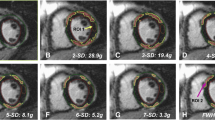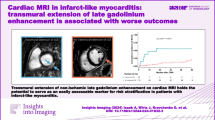Abstract
Objective
To evaluate the prognostic value of late gadolinium enhancement (LGE) in myocarditis and clinically suspected myocarditis.
Methods
The study was registered in PROSPERO (CRD42019144976). A systematic search of PubMed, Ovid Medline, Embase, Web of Science and the Cochrane Central Register of Controlled Trials was completed. Major adverse cardiac event (MACE) was defined as the combination of all-cause mortality or cardiovascular death, resuscitated cardiac arrest, heart transplantation, appropriate implantable cardioverter-defibrillator shock, rehospitalisation following a cardiac event and recurrent acute myocarditis. Combined outcome was defined as the combination of all adverse events. Pooled odds ratios (ORs) and 95% confidence intervals (CIs) were calculated to evaluate the prognostic value of LGE.
Results
Eight articles including 1319 patients (mean age, 38.8 ± 12.9 years) were included in the meta-analysis. The study showed that positive LGE was strongly associated with an increased risk of combined outcome (pooled OR, 5.85; 95% CI, 2.88 to 11.86; p < 0.001) and of MACE (pooled OR, 4.57; 95% CI, 2.18 to 9.59; p < 0.001). Additionally, in a subgroup analysis with mean ejection fraction (EF) point of 50%, the pooled ORs for the combined outcome were 6.46 for left ventricular EF (LVEF) > 50% and 7.90 for LVEF ≤ 50%, and the pooled ORs for MACE were 9.03 and 3.45, respectively. After 3 years of follow-up, the worse outcomes occurred mainly in patients with positive LGE.
Conclusion
Positive LGE is a powerful prognosticator of adverse outcome in myocarditis and clinically suspected myocarditis, irrespective of LVEF.
Key Points
• Forty-four percent to 100% of myocarditis patients have positive late gadolinium enhancement.
• Positive LGE was a powerful prognosticator of adverse outcome in myocarditis and clinically suspected myocarditis, irrespective of LVEF.
• LGE-CMR is important tool for risk stratification in myocarditis and clinically suspected myocarditis.






Similar content being viewed by others
Explore related subjects
Discover the latest articles and news from researchers in related subjects, suggested using machine learning.Abbreviations
- CI:
-
Confidence interval
- CMR:
-
Cardiovascular magnetic resonance
- DCM:
-
Dilated cardiomyopathy
- ECMO:
-
Extracorporeal membrane oxygenation
- EDVI:
-
End-diastolic volume index
- EF:
-
Ejection fraction
- EMB:
-
Endomyocardial biopsy
- HCM:
-
Hypertrophic cardiomyopathy
- HR:
-
Hazard ratio
- I 2 :
-
Inconsistency index
- ICD:
-
Implantable cardioverter-defibrillator
- LGE:
-
Late gadolinium enhancement
- LLC:
-
Lake Louise Criteria
- LV:
-
Left ventricular
- MACE:
-
Major adverse cardiac event
- OR:
-
Odds ratios
- PRISMA:
-
Preferred Reporting Items for Systematic Reviews and Meta-analyses
- RCT:
-
Randomised controlled trial
- RV:
-
Right ventricular
- SCD:
-
Sudden cardiac death
- VAD:
-
Ventricular assist device
References
Ferreira VM, Schulz-Menger J, Holmvang G et al (2018) Cardiovascular magnetic resonance in nonischemic myocardial inflammation: expert recommendations. J Am Coll Cardiol 72:3158–31762
Richardson P, McKenna W, Bristow M et al (1996) Report of the 1995 World Health Organization/International Society and Federation of Cardiology Task Force on the definition and classification of cardiomyopathies. Circulation 93:841–842
Leone O, Veinot JP, Angelini A et al (2012) 2011 consensus statement on endomyocardial biopsy from the Association for European Cardiovascular Pathology and the Society for Cardiovascular Pathology. Cardiovasc Pathol 21:245–274
Caforio AL, Pankuweit S, Arbustini E et al (2013) Current state of knowledge on aetiology, diagnosis, management, and therapy of myocarditis: a position statement of the European Society of Cardiology Working Group on myocardial and pericardial diseases. Eur Heart J 34:2636–2648 2648a-d
Basso C, Calabrese F, Corrado D, Thiene G (2001) Postmortem diagnosis in sudden cardiac death victims: macroscopic, microscopic and molecular findings. Cardiovasc Res 50:290–300
Gore I, Saphir O (1947) Myocarditis; a classification of 1402 cases. Am Heart J 34:827–830
Mason JW, O'Connell JB, Herskowitz A et al (1995) A clinical trial of immunosuppressive therapy for myocarditis. The Myocarditis Treatment Trial Investigators. N Engl J Med 333:269–275
Felker GM, Hu W, Hare JM, Hruban RH, Baughman KL, Kasper EK (1999) The spectrum of dilated cardiomyopathy. The Johns Hopkins experience with 1,278 patients. Medicine (Baltimore) 78:270–283
Towbin JA, Lowe AM, Colan SD et al (1867) Incidence, causes, and outcomes of dilated cardiomyopathy in children. JAMA 296:1867–1876
Friedrich MG, Sechtem U, Schulz-Menger J et al (2009) Cardiovascular magnetic resonance in myocarditis: a JACC white paper. J Am Coll Cardiol 53:1475–1487
Yilmaz A, Ferreira V, Klingel K, Kandolf R, Neubauer S, Sechtem U (2013) Role of cardiovascular magnetic resonance imaging (CMR) in the diagnosis of acute and chronic myocarditis. Heart Fail Rev 18:747–760
Kuruvilla S, Adenaw N, Katwal AB, Lipinski MJ, Kramer CM, Salerno M (2014) Late gadolinium enhancement on cardiac magnetic resonance predicts adverse cardiovascular outcomes in nonischemic cardiomyopathy: a systematic review and meta-analysis. Circ Cardiovasc Imaging 7:250–258
Weng Z, Yao J, Chan RH et al (2016) Prognostic value of LGE-CMR in HCM: a meta-analysis. JACC Cardiovasc Imaging 9:1392–1402
Di Marco A, Anguera I, Schmitt M et al (2017) Late gadolinium enhancement and the risk for ventricular arrhythmias or sudden death in dilated cardiomyopathy: systematic review and meta-analysis. JACC Heart Fail 5:28–38
Grun S, Schumm J, Greulich S et al (2012) Long-term follow-up of biopsy-proven viral myocarditis: predictors of mortality and incomplete recovery. J Am Coll Cardiol 59:1604–1615
Grani C, Eichhorn C, Biere L et al (2017) Prognostic value of cardiac magnetic resonance tissue characterization in risk stratifying patients with suspected myocarditis. J Am Coll Cardiol 70:1964–1976
Martinez-Villar M, Gran F, Sabate-Rotes A et al (2018) Acute myocarditis with infarct-like presentation in a pediatric population: role of cardiovascular magnetic resonance. Pediatr Cardiol 39:51–56
Mavrogeni S, Spargias C, Bratis C et al (2011) Myocarditis as a precipitating factor for heart failure: evaluation and 1-year follow-up using cardiovascular magnetic resonance and endomyocardial biopsy. Eur J Heart Fail 13:830–837
Blissett S, Chocron Y, Kovacina B, Afilalo J (2019) Diagnostic and prognostic value of cardiac magnetic resonance in acute myocarditis: a systematic review and meta-analysis. Int J Cardiovasc Imaging. https://doi.org/10.1007/s10554-019-01674-x
Moher D, Liberati A, Tetzlaff J, Altman DG, PRISMA Group (2009) Preferred reporting items for systematic reviews and meta-analyses: the PRISMA statement. PLoS Med 6:e1000097
Grigoratos C, Barison A, Ivanov A et al (2019) Meta-analysis of the prognostic role of late gadolinium enhancement and global systolic impairment in left ventricular noncompaction. JACC Cardiovasc Imaging. https://doi.org/10.1016/j.jcmg.2018.12.029
Gargiulo G, Goette A, Tijssen J et al (2019) Safety and efficacy outcomes of double vs. triple antithrombotic therapy in patients with atrial fibrillation following percutaneous coronary intervention: a systematic review and meta-analysis of non-vitamin K antagonist oral anticoagulant-based randomized clinical trials. Eur Heart J 40:3757–3767
Aquaro GD, Perfetti M, Camastra G et al (2017) Cardiac MR with late gadolinium enhancement in acute myocarditis with preserved systolic function: ITAMY study. J Am Coll Cardiol 70:1977–1987
Grani C, Biere L, Eichhorn C et al (2019) Incremental value of extracellular volume assessment by cardiovascular magnetic resonance imaging in risk stratifying patients with suspected myocarditis. Int J Cardiovasc Imaging 35:1067–1078
Lee JW, Jeong YJ, Lee G et al (2017) Predictive value of cardiac magnetic resonance imaging-derived myocardial strain for poor outcomes in patients with acute myocarditis. Korean J Radiol 18:643–654
Schumm J, Greulich S, Wagner A et al (2014) Cardiovascular magnetic resonance risk stratification in patients with clinically suspected myocarditis. J Cardiovasc Magn Reson 16:14
Sachdeva S, Song X, Dham N, Heath DM, DeBiasi RL (2015) Analysis of clinical parameters and cardiac magnetic resonance imaging as predictors of outcome in pediatric myocarditis. Am J Cardiol 115:499–504
Wu S, Yang YM, Zhu J et al (2017) Clinical characteristics and outcomes of patients with myocarditis mimicking ST-segment elevation myocardial infarction: analysis of a case series. Medicine (Baltimore) 96:e6863
Luetkens JA, Petry P, Kuetting D et al (2018) Left and right ventricular strain in the course of acute myocarditis: a cardiovascular magnetic resonance study. Rofo 190:722–732
Faletti R, Gatti M, Baralis I et al (2017) Clinical and magnetic resonance evolution of "infarct-like" myocarditis. Radiol Med 122:273–279
Luetkens JA, Homsi R, Dabir D et al (2016) Comprehensive cardiac magnetic resonance for short-term follow-up in acute myocarditis. J Am Heart Assoc. https://doi.org/10.1161/JAHA.116.003603
Zagrosek A, Abdel-Aty H, Boye P et al (2009) Cardiac magnetic resonance monitors reversible and irreversible myocardial injury in myocarditis. JACC Cardiovasc Imaging 2:131–138
Vermes E, Childs H, Faris P, Friedrich MG (2014) Predictive value of CMR criteria for LV functional improvement in patients with acute myocarditis. Eur Heart J Cardiovasc Imaging 15:1140–1144
Sanguineti F, Garot P, Mana M et al (2015) Cardiovascular magnetic resonance predictors of clinical outcome in patients with suspected acute myocarditis. J Cardiovasc Magn Reson 17:78
Funding
This study has received funding by the National Natural Science Foundation of China (contract grant numbers: 81571638) and 1·3·5 project for disciplines of excellence, West China Hospital, Sichuan University (No: ZYJC18013).
Author information
Authors and Affiliations
Corresponding authors
Ethics declarations
Guarantor
The scientific guarantor of this publication is Yucheng Chen.
Conflict of interest
The authors of this manuscript declare no relationships with any companies whose products or services may be related to the subject matter of the article.
Statistics and biometry
No complex statistical methods were necessary for this paper.
Informed consent
Written informed consent was not required for this study because only published data were used.
Ethical approval
Institutional Review Board approval was not required because only published data were used.
Study subjects or cohorts overlap
Studies with duplicate data was excluded from the meta-analysis.
Methodology
• Multicentre study
Additional information
Publisher’s note
Springer Nature remains neutral with regard to jurisdictional claims in published maps and institutional affiliations.
Electronic supplementary material
ESM 1
(DOCX 3328 kb)
Rights and permissions
About this article
Cite this article
Yang, F., Wang, J., Li, W. et al. The prognostic value of late gadolinium enhancement in myocarditis and clinically suspected myocarditis: systematic review and meta-analysis. Eur Radiol 30, 2616–2626 (2020). https://doi.org/10.1007/s00330-019-06643-5
Received:
Revised:
Accepted:
Published:
Issue Date:
DOI: https://doi.org/10.1007/s00330-019-06643-5




